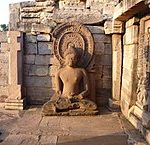3/11 Practice Circle: Mindfulness of the Body
 I’ve been reading Beth Ann Mulligan’s “The Dharma of Modern Mindfulness,” which is impressive for the way she uses anecdotes from her secular MBSR course to illustrate basic Buddhist principles. In that spirit, when Practice Circle meets again this Sunday, March 11, at 6 p.m. Pacific, 8 Central and 9 Eastern, we’ll begin a four-part examination of the Four Foundations of Mindfulness with a practice of Mindfulness of the Body. I’ve shared an excerpt from Mulligan’s book below.Click here to join our free video conference group Sunday night!
I’ve been reading Beth Ann Mulligan’s “The Dharma of Modern Mindfulness,” which is impressive for the way she uses anecdotes from her secular MBSR course to illustrate basic Buddhist principles. In that spirit, when Practice Circle meets again this Sunday, March 11, at 6 p.m. Pacific, 8 Central and 9 Eastern, we’ll begin a four-part examination of the Four Foundations of Mindfulness with a practice of Mindfulness of the Body. I’ve shared an excerpt from Mulligan’s book below.Click here to join our free video conference group Sunday night!
The First Foundation of Mindfulness: Mindfulness of the Body
The First Foundation of Mindfulness, said the Buddha, is awareness of the body, starting by placing awareness on the breath. This is a fundamental practice in MBSR and in many Buddhist and other wisdom practices. He doesn’t tell us how to breathe, but rather suggests that we “know a long breath to be long and a short breath to be short, we know an in breath and we know and out breath.” In other words, he invites us to simply be aware of our breath as it is naturally. In MBRS we give instructions like: “Feel the breath” or “Be aware of the sensations of a breath, the rising and falling of the chest and belly.” We don’t actually teach people how to breathe. What’s funny is that when you ask people what was most useful in the class, they often respond: “The breathing.” And I want to ask in that moment, “What breathing? The one you’ve been doing all your life?” What they really mean is they found refuge in simply directing their attention to what is already and always happening. This is in part, I think, why the Buddha emphasized breathing practice so strongly. Many folks, myself included, have found this practice to be a direct path to freedom, if only for a moment . . .
The instructions on the First Foundation of Mindfulness in and of the body go on to invite awareness of postures — sitting, standing, walking, and lying down — as well as a reflection on what the body is made up of: fluids, bones, organs hair, nails, teeth, flesh, sinews, and so on. . . The Buddha doesn’t ask us to judge the body or change the body, but to place our mindfulness there, which allows us to get to know it and attend to it . . . I had a lovely young woman student who struggled a lot with body image. She was constantly thinking about her weight and her appearance; it was a source of great suffering for her and nothing she had tried before could break the grip of these thoughts. After trying the body scan and mindful walking, she reported, “I wasn’t fat, I wasn’t thin, I wasn’t too anything. I was just me standing. Suddenly I felt so much gratitude for my feet and legs, I felt so grateful for this body. And then I realized that everyone has one–a body, I mean–and it may sound strange, but I felt less alone. I don’t know if I have ever felt this way before.” Tears streamed down her face, and a profound transformation had begun simply by bringing mindfulness into the body.
Beth Ann Mulligan
